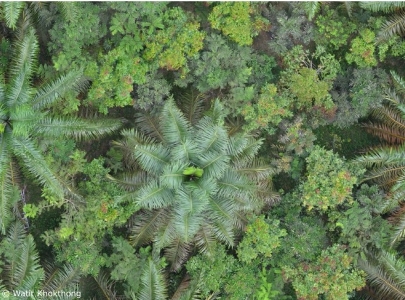Tree Islands for Biodiversity in Oil Palm Plantations

The trees planted in the centre of oil palm plantations that resemble islands and are referred to as “tree islands” have been found to significantly increase biodiversity within five years. This increase in biodiversity can be achieved without compromising oil palm production.
This has been proven through a long-term study led by the Collaborative Research Centre Ecological and Socio-Economic Functions of Tropical Lowland Rainforest Transformation Systems – Sumatra, Indonesia (EFForTS), University of Göttingen, Germany.
The research activities are in collaboration with several Indonesian universities, such as IPB University and Jambi University. The researchers saw the loss of biodiversity due to intensive oil palm cultivation, so they planted tree islands on the island of Sumatra, specifically in Jambi. The results of this research have been published in the journal Nature, one of the oldest and most reputable scientific journals in the world.
The conversion of tropical forests to oil palm plantations results in a significant loss of biodiversity and ecological function. The world’s oil palm plantations are currently around 21 million hectares with the majority located in Indonesia and Malaysia. To reduce negative environmental impacts, researchers created 52 tree islands of six local tree species in industrial oil palm plantations. This turned out to be a promising ecological restoration strategy.
Initially, the research team predicted that yields would decline over time as the tree islands consumed resources for growth at the expense of the oil palms.
“However, this did not happen, even five years after the start of the experiment, and that was without increasing the use of artificial fertilisers on the tree islands,” said first author Prof Delphine Clara Zemp, currently at the University of Neuchâtel, Switzerland.
“The study results show that the industry can benefit from this measure. There is real potential to develop these ecological restoration practices on a large scale,” she adds.
“Generally, ecological studies on oil palm are limited to reporting biodiversity loss and ecosystem degradation,” explained co-author Prof Holger Kreft, Head of the Biodiversity, Macroecology and Biogeography Research Group at the University of Göttingen, Germany.
“Our approach to ecological restoration goes a step further and is unique in that it takes place against the backdrop of an industrial-scale oil palm plantation (140 hectares). With a rigorous experimental design, we determined the optimal island composition and size that could result in the best ecological restoration,” stated Prof Holger Kreft.
Over several years, the researchers analysed the biodiversity of bacteria, fungi, plants and animals. The research team also measured the impact of regulation of water, carbon and nutrient cycling, microclimate, soil quality, pollination, biological interactions and control of invasive species. As such, close collaboration with plantation managers is essential.
“This helps us to better consider the agronomic aspects of plantations and how these experiments affect oil palm production. This aspect is very important for the industry,” explained Prof Delphine Clara Zemp.
“This study involved more than 40 researchers from various research and educational institutions around the world, showing commitment and collaboration in better environmental management, especially in addressing the negative impacts of intensive oil palm cultivation,” said team member Prof Damayanti Buchori from IPB University.
However, the team agreed that the top priority remains ‘preventing deforestation’. “These encouraging results should not be allowed to jeopardise the conservation of tropical forests, home to irreplaceable biodiversity,” the team concluded. (*/0Rz) (IAAS/RUM)
The original publication manuscript can be accessed in the following link:
Delphine Clara Zemp et al. Tree islands enhance biodiversity and functioning in oil palm landscapes. Nature 2023. https://www.nature.com/articles/s41586-023-06086-5



